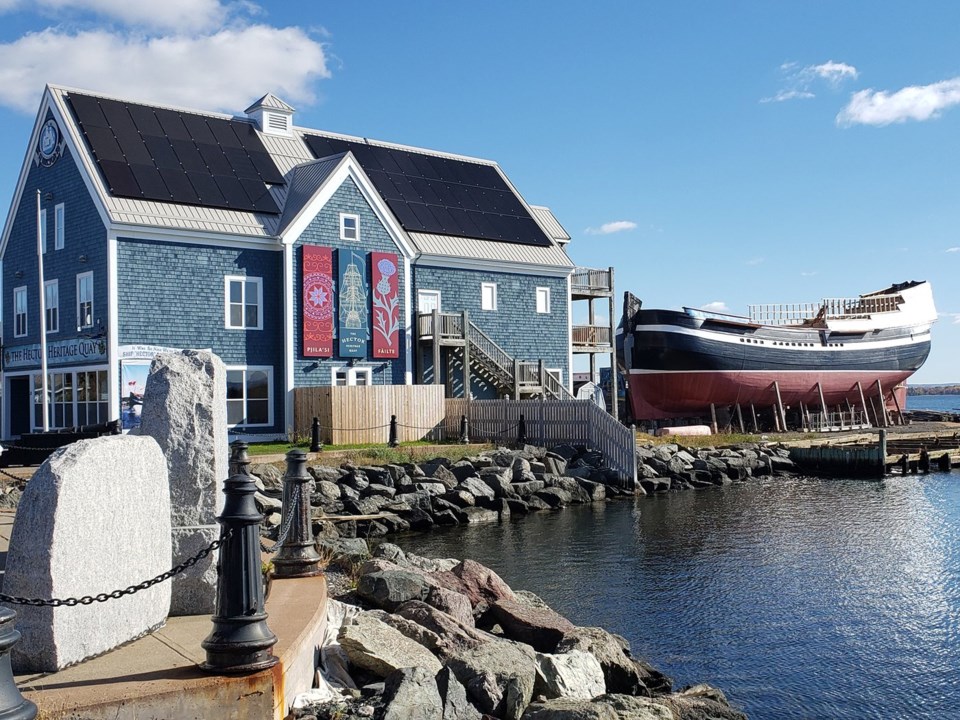PICTOU — A restored replica of the square-rigged sailing ship that sparked a wave of Scottish immigration to Nova Scotia is set for a rebirth in the harbour where the vessel first arrived more than 250 years ago.
After a restoration and public fundraising effort that began in 2019, the rebuilt hull of the Hector is scheduled to be side-launched -- eased into the water sideways -- during a ceremony on Saturday at the scenic harbour in Pictou, N.S.
During the traditional launch, the vessel will slide down seven ramps -- known as launchways -- after supporting wedges are removed, a process master shipbuilder Vern Shea said will be a sight to see.
“It’s kind of nerve-wracking,” Shea said in a recent interview. “I’ve witnessed quite a few launches in my career and you always get the hair on the back of your neck rising and the goosebumps every time you see it.”
Shea was instrumental in the original build of the Hector replica, which was not fit for sailing, and was installed in the year 2000 next to the interpretive centre and outbuildings of the Hector Heritage Quay. The wooden vessel was built from the original designs, using traditional methods and materials, Shea said.
But over the years the vessel wasn't properly maintained and it fell into disrepair before the Ship Hector Society bought it for a few dollars in 2010 from the town of Pictou. The society has spearheaded a $4-million fundraising effort for the latest restoration, which has required an extensive rebuild to eventually transform the Hector into a fully working sailing vessel.
“It was the vision to sail it, it’s been my hope all this time,” said Shea. “It’s becoming a reality, which is very fulfilling.”
Shea, who also worked on the engineering drawings for the rebuild of Nova Scotia’s iconic schooner Bluenose II, said the latest rebuild of the Hector required all of the hull planking above the ship’s waterline to be removed and replaced because of rot. The ship was then covered in fibreglass for added protection.
“We replaced all of the rotten planks up to the main deck with Douglas fir planking and then we filled the seams with pine and then used two layers of fibreglass,” Shea said.
Inside the hull are two cramped compartments built as they would have been in 1773, when 189 men, women and children made the harrowing 11-week voyage during which smallpox claimed 18 lives.
“It would have been cramped and it would have been putrid and it would have been disgusting, there’s no two ways about it,” said Shea. “They (settlers) endured a lot to get here."
On its website, the Hector society says, "Those who arrived aboard the Hector, as well as those Scottish settlers who followed, made enormous cultural, political, intellectual and industrial contributions that shaped Nova Scotia and the rest of Canada.
"This historic voyage marked the beginning of a massive wave of immigration that would shape the future of North America and gave Pictou the honour of being called 'The Birthplace of New Scotland.'"
Once the vessel is in the water, the next phase of the project will begin -- installing electric motors along with masts and sails. It’s hoped the newly refurbished Hector will be ready for harbour tours by 2027, said society chair Wes Surett. He said just over $2 million in public funds has been raised so far for the project, with another $1.8 million to go to finish the ship.
Surett said the interpretive centre opened last month after an extensive revamp through funding from the federal and provincial governments. He said it tells the story of the Scots and the local Mi’kmaq inhabitants who helped them, through interactive displays, audio-visual aids and a new panoramic theatre presentation.
“It really does a great interactive job of telling the story of survival and how the Celtic culture and the Mi’kmaq culture intertwined,” said Surett.
Future plans for the site also include the addition of a sailing program along with a wooden shipbuilding school; however, Surett said a Hector that can finally set sail will be the real money-maker.
“We really see it (the ship) and that sailing experience generating the revenue to sustain the attraction long-term,” he said.
This report by The Canadian Press was first published July 12, 2025.
-- By Keith Doucette in Halifax
The Canadian Press



